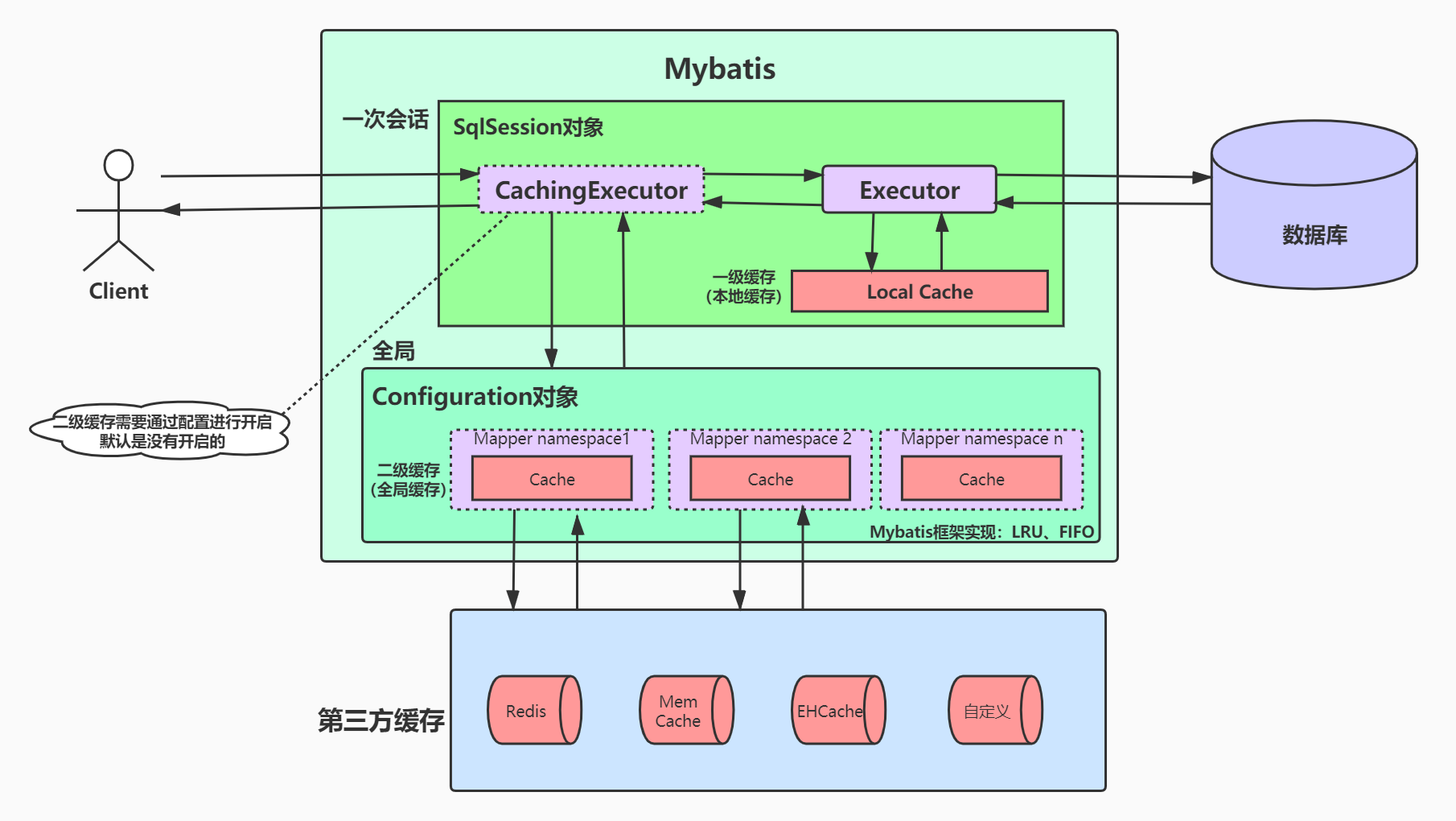MyBatis缓存之一级缓存(SqlSession级别)二级缓存(Mapper级别)原理
MyBatis的缓存分为一级缓存和二级缓存(全局缓存),缓存示意图如下图所示。默认情况下,一级缓存是开启的,且不能被关闭。MyBatis的一级缓存(SqlSession级别)在同一个SqlSession中执行相同的SQL语句时,将查询结果集缓存,第二次查询时直接取缓存,不在操作数据库。注意:一级缓存最多缓存1024条SQL语句。原理: 当客户端第一次发出SQL查询语句时,MyBatis执行SQL的
MyBatis的缓存分为一级缓存和二级缓存(全局缓存) ,缓存示意图如下图所示。默认情况下,一级缓存是开启的,且不能被关闭。

MyBatis的一级缓存(SqlSession级别)
在同一个SqlSession中执行相同的SQL语句时,将查询结果集缓存,第二次查询时直接取缓存,不在操作数据库。注意:一级缓存最多缓存1024条SQL语句。
原理: 当客户端第一次发出SQL查询语句时,MyBatis执行SQL的查询并将查询结果写入SqlSession的一级缓存中,当第二次相同的SQL的查询语句过来时,则直接从缓存中获取数据,具体过程如上图所示。缓存使用的数据结构是Map,其中key是 MapperId+Offset+Limit+SQL+所有的入参。
同一个SqlSession操作相同的SQL语句,如中间有修改操作时,需不要手动flush?
不需要!!!
当同一个SqlSession多次发出相同的SQL语句查询时,MyBatis会直接从缓存中取数据。如果前后两次中间出现过commit操作(修改、添加、删除),则认为数据发生了变化,MyBatis会把SqlSession中的一级缓存区域全部清空,则下一次的SQL语句查询时,需从数据库中查询数据并将查询的结果写入缓存。
1、MyBatis的一级缓存是SqlSession级别的,但是它并不定义在SqlSessio接口的实现类DefaultSqlSession中,而是定义在DefaultSqlSession的成员变量Executor中,Executor是在openSession的时候被实例化出来的,它的默认实现为SimpleExecutor
2、MyBatis中的一级缓存,与有没有配置无关,只要SqlSession存在,MyBastis一级缓存就存在,localCache的类型是PerpetualCache,它其实很简单,一个id属性+一个HashMap属性而已,id是一个名为"localCache"的字符串,HashMap用于存储数据,Key为CacheKey,Value为查询结果
3、MyBatis的一级缓存查询的时候默认都是会先尝试从一级缓存中获取数据的,但是我们看第6行的代码做了一个判断,ms.isFlushCacheRequired(),即想每次查询都走DB也行,将<select>标签中的flushCache属性设置为true即可,这意味着每次查询的时候都会清理一遍PerpetualCache,PerpetualCache中没数据,自然只能走DB
从MyBatis一级缓存来看,它以单纯的HashMap做缓存,没有容量控制,而一次SqlSession中通常来说并不会有大量的查询操作,因此只适用于一次SqlSession,如果用到二级缓存的Mapper级别的场景,有可能缓存数据不断碰到而导致内存溢出。
<insert>、<delete>、<update>最终都会转换为update方法,看一下BaseExecutor的update方法:
public int update(MappedStatement ms, Object parameter) throws SQLException {
ErrorContext.instance().resource(ms.getResource()).activity("executing an update").object(ms.getId());
if (closed) {
throw new ExecutorException("Executor was closed.");
}
clearLocalCache();
return doUpdate(ms, parameter);
}clearLocalCache()方法 =====> 所有的增、删、改都会清空缓存,这和是否配置了flushCache=true是无关的。
namespace+id 其中namespace为Mapper的全量名!
MyBatis的二级缓存(Mapper级别,全局缓存)
跨SqlSession的缓存,Mapper级别的缓存。在Mapper级别的缓存内,不同的SQLSession缓存可以共享。
原理: Mapper级别,Mapper以命名空间为单位创建缓存数据结构,缓存使用的数据结构是Map,其中key是 MapperId+Offset+Limit+SQL+所有的入参。MyBatis的二级缓存是CacheExecutor实现的。CacheExecutor是Executor的代理对象。当MyBatis接收到用户的查询请求时首先会根据Map的Key在CacheExecute缓存中查询数据是否存在,存在则从缓存中取,否则将执行数据库查询操作。
开启二级缓存需要进行相关配置:
- MyBatis全局配置中启用二级缓存配置 CacheEnable=true;
- 在对应的Mapper文件中配置Cache节点;
- 在对应的Select标签中添加useCache=true;
MyBatis中的Cache接口
public interface Cache {
/**
* @return The identifier of this cache
*/
String getId();
/**
* @param key Can be any object but usually it is a {@link CacheKey}
* @param value The result of a select.
*/
void putObject(Object key, Object value);
/**
* @param key The key
* @return The object stored in the cache.
*/
Object getObject(Object key);
/**
* Optional. It is not called by the core.
*
* @param key The key
* @return The object that was removed
*/
Object removeObject(Object key);
/**
* Clears this cache instance
*/
void clear();
/**
* Optional. This method is not called by the core.
*
* @return The number of elements stored in the cache (not its capacity).
*/
int getSize();
/**
* Optional. As of 3.2.6 this method is no longer called by the core.
*
* Any locking needed by the cache must be provided internally by the cache provider.
*
* @return A ReadWriteLock
*/
ReadWriteLock getReadWriteLock();
} public CacheKey createCacheKey(MappedStatement ms, Object parameterObject, RowBounds rowBounds, BoundSql boundSql) {
if (closed) throw new ExecutorException("Executor was closed.");
CacheKey cacheKey = new CacheKey();
cacheKey.update(ms.getId());
cacheKey.update(rowBounds.getOffset());
cacheKey.update(rowBounds.getLimit());
cacheKey.update(boundSql.getSql());
List<ParameterMapping> parameterMappings = boundSql.getParameterMappings();
TypeHandlerRegistry typeHandlerRegistry = ms.getConfiguration().getTypeHandlerRegistry();
for (int i = 0; i < parameterMappings.size(); i++) { // mimic DefaultParameterHandler logic
ParameterMapping parameterMapping = parameterMappings.get(i);
if (parameterMapping.getMode() != ParameterMode.OUT) {
Object value;
String propertyName = parameterMapping.getProperty();
if (boundSql.hasAdditionalParameter(propertyName)) {
value = boundSql.getAdditionalParameter(propertyName);
} else if (parameterObject == null) {
value = null;
} else if (typeHandlerRegistry.hasTypeHandler(parameterObject.getClass())) {
value = parameterObject;
} else {
MetaObject metaObject = configuration.newMetaObject(parameterObject);
value = metaObject.getValue(propertyName);
}
cacheKey.update(value);
}
}
return cacheKey;
} 1、<select>标签所在的Mapper的Namespace+<select>标签的id属性
2、RowBounds的offset和limit属性,RowBounds是MyBatis用于处理分页的一个类,offset默认为0,limit默认为Integer.MAX_VALUE
3、<select>标签中定义的sql语句
即只要两次查询满足以上三个条件且没有定义flushCache="true",那么第二次查询会直接从MyBatis一级缓存PerpetualCache中返回数据,而不会走DB。
/**
* @author Clinton Begin
*/
public final class MappedStatement {
private String resource;
private Configuration configuration;
private String id;
private Integer fetchSize;
private Integer timeout;
private StatementType statementType;
private ResultSetType resultSetType;
private SqlSource sqlSource;
private Cache cache;
private ParameterMap parameterMap;
private List<ResultMap> resultMaps;
private boolean flushCacheRequired;
private boolean useCache;
private boolean resultOrdered;
private SqlCommandType sqlCommandType;
private KeyGenerator keyGenerator;
private String[] keyProperties;
private String[] keyColumns;
private boolean hasNestedResultMaps;
private String databaseId;
private Log statementLog;
private LanguageDriver lang;
private String[] resultSets;
private MappedStatement() {
// constructor disabled
}
public static class Builder {
private MappedStatement mappedStatement = new MappedStatement();
public Builder(Configuration configuration, String id, SqlSource sqlSource, SqlCommandType sqlCommandType) {
mappedStatement.configuration = configuration;
mappedStatement.id = id;
mappedStatement.sqlSource = sqlSource;
mappedStatement.statementType = StatementType.PREPARED;
mappedStatement.parameterMap = new ParameterMap.Builder(configuration, "defaultParameterMap", null, new ArrayList<ParameterMapping>()).build();
mappedStatement.resultMaps = new ArrayList<ResultMap>();
mappedStatement.timeout = configuration.getDefaultStatementTimeout();
mappedStatement.sqlCommandType = sqlCommandType;
mappedStatement.keyGenerator = configuration.isUseGeneratedKeys() && SqlCommandType.INSERT.equals(sqlCommandType) ? new Jdbc3KeyGenerator() : new NoKeyGenerator();
String logId = id;
if (configuration.getLogPrefix() != null) logId = configuration.getLogPrefix() + id;
mappedStatement.statementLog = LogFactory.getLog(logId);
mappedStatement.lang = configuration.getDefaultScriptingLanuageInstance();
}
public Builder resource(String resource) {
mappedStatement.resource = resource;
return this;
}
public String id() {
return mappedStatement.id;
}
public Builder parameterMap(ParameterMap parameterMap) {
mappedStatement.parameterMap = parameterMap;
return this;
}
public Builder resultMaps(List<ResultMap> resultMaps) {
mappedStatement.resultMaps = resultMaps;
for (ResultMap resultMap : resultMaps) {
mappedStatement.hasNestedResultMaps = mappedStatement.hasNestedResultMaps || resultMap.hasNestedResultMaps();
}
return this;
}
public Builder fetchSize(Integer fetchSize) {
mappedStatement.fetchSize = fetchSize;
return this;
}
public Builder timeout(Integer timeout) {
mappedStatement.timeout = timeout;
return this;
}
public Builder statementType(StatementType statementType) {
mappedStatement.statementType = statementType;
return this;
}
public Builder resultSetType(ResultSetType resultSetType) {
mappedStatement.resultSetType = resultSetType;
return this;
}
public Builder cache(Cache cache) {
mappedStatement.cache = cache;
return this;
}
public Builder flushCacheRequired(boolean flushCacheRequired) {
mappedStatement.flushCacheRequired = flushCacheRequired;
return this;
}
public Builder useCache(boolean useCache) {
mappedStatement.useCache = useCache;
return this;
}
public Builder resultOrdered(boolean resultOrdered) {
mappedStatement.resultOrdered = resultOrdered;
return this;
}
public Builder keyGenerator(KeyGenerator keyGenerator) {
mappedStatement.keyGenerator = keyGenerator;
return this;
}
public Builder keyProperty(String keyProperty) {
mappedStatement.keyProperties = delimitedStringtoArray(keyProperty);
return this;
}
public Builder keyColumn(String keyColumn) {
mappedStatement.keyColumns = delimitedStringtoArray(keyColumn);
return this;
}
public Builder databaseId(String databaseId) {
mappedStatement.databaseId = databaseId;
return this;
}
public Builder lang(LanguageDriver driver) {
mappedStatement.lang = driver;
return this;
}
public Builder resulSets(String resultSet) {
mappedStatement.resultSets = delimitedStringtoArray(resultSet);
return this;
}
public MappedStatement build() {
assert mappedStatement.configuration != null;
assert mappedStatement.id != null;
assert mappedStatement.sqlSource != null;
assert mappedStatement.lang != null;
mappedStatement.resultMaps = Collections.unmodifiableList(mappedStatement.resultMaps);
return mappedStatement;
}
}
public boolean hasNestedResultMaps() {
return hasNestedResultMaps;
}
public BoundSql getBoundSql(Object parameterObject) {
BoundSql boundSql = sqlSource.getBoundSql(parameterObject);
List<ParameterMapping> parameterMappings = boundSql.getParameterMappings();
if (parameterMappings == null || parameterMappings.size() <= 0) {
boundSql = new BoundSql(configuration, boundSql.getSql(), parameterMap.getParameterMappings(), parameterObject);
}
// check for nested result maps in parameter mappings (issue #30)
for (ParameterMapping pm : boundSql.getParameterMappings()) {
String rmId = pm.getResultMapId();
if (rmId != null) {
ResultMap rm = configuration.getResultMap(rmId);
if (rm != null) {
hasNestedResultMaps |= rm.hasNestedResultMaps();
}
}
}
return boundSql;
}
private static String[] delimitedStringtoArray(String in) {
if (in == null || in.trim().length() == 0) {
return null;
} else {
String[] answer = in.split(",");
return answer;
}
}
}
一二级缓存之间的关系
public Executor newExecutor(Transaction transaction, ExecutorType executorType) {
executorType = executorType == null ? defaultExecutorType : executorType;
executorType = executorType == null ? ExecutorType.SIMPLE : executorType;
Executor executor;
if (ExecutorType.BATCH == executorType) {
executor = new BatchExecutor(this, transaction);
} else if (ExecutorType.REUSE == executorType) {
executor = new ReuseExecutor(this, transaction);
} else {
executor = new SimpleExecutor(this, transaction);
}
// 如果开启二级缓存会使用CachingExecutor对原Executor进行包装
if (cacheEnabled) {
executor = new CachingExecutor(executor);
}
// Mybatis插件功能对Executor的增强
executor = (Executor) interceptorChain.pluginAll(executor);
return executor;
}更多推荐
 已为社区贡献12条内容
已为社区贡献12条内容









所有评论(0)